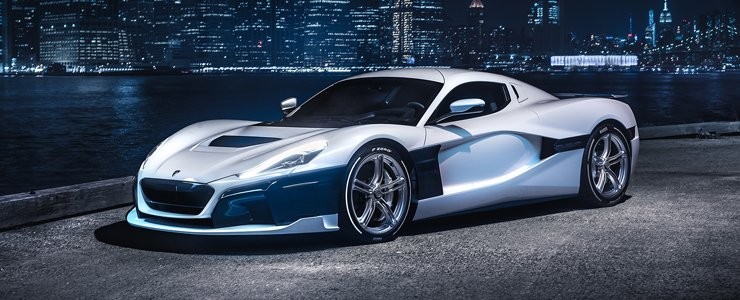Search the Community
Showing results for tags 'Pininfarina'.
-
Wearnes Automotive, a leading distributor and retailer of premium cars in South East Asia, has announced that the company will be the exclusive partner of Koenigsegg, Pininfarina and Rimac. These brands will be part of the Prestige Division which recently added Alpine and Lotus to its stable of brands that include Aston Martin and Bentley. The company will be able to sell Koenigsegg, Pininfarina and Rimac hypercars across Asia. "These three new brands will add to the portfolio in our Prestige Division. Coupled with our expertise and experience in the ultra-luxury segment, we are confident of further strengthening our position in this segment." says Mr. Andre Roy, Chief Executive Officer. To help high-end car collectors enhance, preserve and protect their investments, Wearnes Automotive has also embarked on building a state-of-the-art, climate-controlled bonded car storage facility in Singapore. This will allow luxury car collectors to store their rare, limited edition and classic cars in an exclusive and secure environment.
- 10 replies
-
- 3
-

-
- wearnes
- koenigsegg
-
(and 2 more)
Tagged with:
-
No physical windscreen but a 'virtual' one. Will the air flow completely prevent flies and any other bugs flying into your face? Hmmmmmm...... "The aerodynamics have allowed us to achieve more interesting results, starting with the creation of a virtual windshield. The elimination of the windshield would, in fact, the arrival of a stream of air pressure increasing with the speed on the head of the driver and the passenger. The engineers and designers at Pininfarina have designed, built and tested an airfoil placed in a shape of the bonnet, which produces a double deflection of the flow of air entering the passenger compartment. The first deviation is made from the wing itself, the second from the air that accelerates the channel created between the airfoil and the corresponding shape of the molding in the trunk. The result is that, thanks to the virtual windshield, the air passes above the heads of the driver and the passenger, greatly increasing the comfort. This effect also contributes to increase the aerodynamic downforce on the front axle of the car. The virtual windscreen is already effective from 50 km/h." http://en.wikipedia.org/wiki/Pininfarina_Sergio
- 1 reply
-
- ferrari
- windscreen
-
(and 3 more)
Tagged with:
-

Sergio Pininfarina exhibition opens at the Ferrari Museum
FaezClutchless posted a blog entry in MyAutoBlog
Just recently, Ferrari announced it will honour the Ferrari cars that Sergio Pininfarina has designed. Sergio Pininfarina passed away in July 2012 and was responsible for the creation of many Ferrari models and among them were the Testarossa and the short wheel base 250GT Berlinetta. On the 26th of October, the Ferrari Museum officially launches the start of the Great Ferraris of Sergio Pininfarina exhibition. The exhibition focuses on the years which Sergio Pininfarina's designs were considered to be very important to Ferrari. Sergio Pininfarina designed many Ferraris but the company has decided to place only twenty-two of them on display in Maranello. Present at the opening ceremony were Luca di Montezemolo (Ferrari chairman), Paolo Pininfarina (president of Pininfarina and also Sergio's son), Pierro Ferrari (Enzo Ferrari's son) and Sergio's wife. The exhibition is divided into three halls; one for race cars, one for concept cars and one for production cars. In the race cars exhibition hall, visitors can take a closer look on the racing cars that Sergio Pininfarina has created such as the 250 LM which won the Le Mans race and also the Sigma Formula One prototype from the late 1960s. One of the unique cars displayed at the concept cars hall is Ferrari's first ever four door car which is the Ferrari Pinin Concept. Also displayed there is the 2.9 litre, 400bhp Ferrari P6 Concept which was produced in 1968. The production cars exhibition is divided into two separate categories. In the front-engines section visitors can view models such as the 1964 275 GTB4 and the Spider version of the Daytona. Cars like the Ferrari Testarossa grace the mid-engined section of the hall. The exhibition is open to the public seven days a week till 07th of January 2013 (closed on the 25th of December and the 01st of January) and tickets can be booked online at museoferrari.com. Photo credit: Ferrari-
- other news
- events
- (and 8 more)
-
The name Sergio Pininfarina is synonymous with excellent looking cars. For those who are not familiar with the name, Sergio Pininfarina was an automotive designer who has designed many cars and most of them were Ferraris. Some of the cars that he designed were the Ferrari Enzo, Ferrari Testarossa, Bentley Azure and the Alfa Romeo 164. Sadly, Sergio Pininfarina passed away this past July and to honour his creations done for Ferrari; the Italian automaker will hold an exhibition at its official museum in Maranello, Italy. The exhibition will be known as Le grandi Ferrari di Sergio Pininfarina (Sergio Pininfarina
-
- events
- other news
- (and 9 more)
-

Sergio Pininfarina leaves behind a legacy of outstanding design
SYF77 posted a blog entry in MyAutoBlog
The automobile industry has lost another legendary designer. Sergio Pininfarina, best known for running the company that bore his name, passed away on 3rd July evening at his home in Turin, Italy. He was 85 years old and no cause of death was given. Born on 8th September 1926, Sergio went on to receive a degree in mechanical engineering from the Polytechnic of Torino in 1950. He started his career at his father's coach building and design company, Carrozzeria Pinin Farina, as the General Manager in 1960. He eventually became the chairman following the death of his father, Battista Pinin Farina, in 1966. During his tenure, the company created some of the most iconic automobiles in history. Among them are, according to chronological order: 1984 Ferrari Testarossa 1986 Fiat 124 Spider 1986 Cadillac Allante 1987 Alfa Romeo 164 1995 Bentley Azure 1996 Peugeot 406 Coupe 2002 Ferrari Enzo 2003 Maserati Quattroporte 2004 Ferrari Scaglietti In 2006, he stepped down as president of Pininfarina and became Honorary Chairman of the company. Pininfarina was active in politics as well. Between 1979 and 1988, he was a Liberal Party Member of the European Parliament (MEP), where his party was a part of the European Liberal Democrat alliance. Pininfarina leaves behind a wife and two sons.- 2 comments
-
- other news
- discussions
- (and 11 more)
-

Bertone and Pininfarina Geneva concept cars aren't that fanciful
Rigval posted a blog entry in MyAutoBlog
The Geneva Motor Show is usually never complete without concept cars. And I must add that any motor show without concept cars on display is quite lame. When it comes to the Geneva Motor Show it is never lame as it is one of the best places to view concept cars as most European manufacturers usually go full force over there. Furthermore, this is also a place where we get to see an Italian Carrozzeria or three showing off their latest concept cars. We have Pininfarina previewing their Cambiano concept (above) and we have Bertone showing of the Nuccio (below). Both Pininfarina and Bertone are two companies responsible for coming out with the design of classics like the Ferrari 365GTB Daytona and the Lamborghini Miura respectively as well as a plethora of supercars, family cars and unique, one of a kind cars for individual customers. But this time I have to say that both have come up with duds this time around. The Pininfarina Cambiano concept is supposedly to celebrate the 30th anniversary of its styling center and the 10th year anniversary of the engineering center. It is an engineering powerhouse in that it showcases the use of electric motors-
- new model
- concept cars
- (and 8 more)
-
Following its world premiere at last year's Geneva Salon, Tata brought its oddly named Pr1ma concept car back home for the New Delhi motor show. Designed and built by famous Italian coachbuilder Pininfarina, the Pr1ma is suppose to offer an indication of how the next generation of Tata saloons could be stylistically interpreted. The compact-size four-door saloon is based on the platform of the first Indian sedan, the Tata Indigo, featuring a wheelbase of 2.700 mm. Neither Tata or Pininfarina have released any more information about the Pr1ma. My best guess is that it will be powered by a range of engines between 1.6L to 2.0L. The styling of the Prlma looks clean yet refreshing to me. The nicely integrated exhaust reminds me of those found in the upmarket Lexus LS460 and the side profile of the car is similar to the peugeot 407. Let's hope that the production model follows the styling cues of the concept closely.
-
RIP.... http://news.yahoo.com/s/nm/20080807/wl_nm/...farina_death_dc MILAN (Reuters) - Andrea Pininfarina, head of the company which designs Ferraris, Fiats and the Ford Focus, died in a road crash in the early hours of Thursday near the Italian city of Turin, riding his Vespa scooter. Pininfarina, 51, was chairman and chief executive of the company founded in 1930. He was the grandson of founder Battista "Pinin" Farina and his death prompted speculation that the entrance of new investors will speed up, sending its shares sharply higher. Prime Minister Silvio Berlusconi said in a statement Pininfarina was "the representative of a dynasty that helped bring the story of 'made in Italy' to the world." Fiat and Ferrari Chairman Luca Cordero di Montezemolo praised his business acumen. "Italy, Turin and the Fiat group have lost a business figure who knew how to follow and develop the work of his grandfather Pinin and his father Sergio," Montezemolo said in a statement. The driver of the car, 78-year-old Giuliano Salmi, was taken to hospital suffering from shock. "I didn't see him, I was going slowly and I really didn't see him," Salmi said, according to local news agency Ansa. Andrea Pininfarina was born in Turin, the centre of Italy's car industry, on June 26, 1957 and joined the family business in 1983 after gaining a degree in mechanical engineering. He was married to Italian aristocrat Cristina Maddalena Pellion di Persano and they had three children. ART AND DESIGN Pininfarina SpA, which designed Ferraris such as the Dino and Testarossa, boasts of "Experience, Creativity, Innovation" on its Website www.pininfarina.com, where it says it is a company of "art, design, innovation. The cars of kings." News of the chief executive's death prompted market speculation that its ownership -- currently in the hands of the family with a 55 percent stake -- could quickly change. The shares jumped so high they had to be suspended in Milan for excessive gains and were indicated up over 13 percent pending a resumption of trade. "The market thinks that ownership change will speed up," said one trader. The family had already planned to cut its stake to around 30 percent through a sale of shares, which the company hopes will raise 100 million euros ($155 million) to be used to develop a new electric car to be launched in 2009. French financier Vincent Bollore could take part, investing up to 30 million euros. Other potential investors include the son of Ferrari's founder and Indian industrialist Ratan Tata. Pininfarina agreed a deal with its creditor banks last week which temporarily exempted it from repayments on 600 million euros of debt while it restructures its finances. It has tried to cut costs as the economic downturn hits car makers and narrowed its loss to 9.7 million euros in the first quarter, from 9.9 million in the same period a year ago. (Additional reporting by Francesca Piscioneri in Rome and Alessandra Farina in Milan; Editing by Greg Mahlich and David Holmes)
- 8 replies
-
- Pininfarina
- dies
-
(and 2 more)
Tagged with:
-
http://news.bbc.co.uk/2/hi/europe/7547267.stm Think this guy designed the Hyundai Matrix?
- 15 replies
-
- News
- Pininfarina
-
(and 2 more)
Tagged with:
-
I have seen the Pininfarina decal stuck right across the top ofthe front windscreen of a few matrix. Could anyone here advise where I can find such decal? I have checked with Komoco but it does not carry them.
-
What do you guys think of the Matrix? Sometimes I think it looks very very ugly yet sometimes I think it looks very very stylish and beautiful and sporty from certain angles. What do you guys think? And also about its black moldings, good or bad?
-
It us quite unusual that the same cars are penned by different designers. They both look good and the Optra 5 rear reminds me of a Alfa.... somehow...
- 18 replies
-
- Optra
- Pininfarina
-
(and 2 more)
Tagged with:
-
http://www.supercars.net/PicFetch?pic=2003_pininfarina_enjoy-1.jpg http://www.supercars.net/PicFetch?pic=2003_pininfarina_enjoy-2.jpg With Enjoy, a roadster for eve ryd ay use also conceived for racing, Pininfarina revisits the sports car theme in its most genuine sense. An easy-going, fun car targeted primarily at young people who place little importance on refinements and superfluous ornament ation. A car for those who pre fer ease-of-use and a real sense of freedom and independence, combined with the pleasure of a sporty driving style but where the emphasis is not just on power and size. So Pininfarina's intention was to design a simple, practical, basic though dynamic barchetta that would be the ideal car for people who, in addition to wa nting an enjoyable drive, also have a passion for racing. This has been achieved thanks to this car's dual personality. An unusual sports car, unlike others, for it establishes a different relationship with the driver: an extraordinarily spontaneous, intimate bond that also implies a sensation of greater awareness and control of the car's behaviour. Sports cars according to Pininfarina The sports car theme runs in Pininfarina's blood. For instance the prolific cooperation with Ferrari that began back in '52 has resulted in the creation of some of the most outstanding sports cars seen during the postwar period, the latest of which was the Barchetta Pininfarina in 2001. The same concept - a no-frills, fun-to-drive sports car accessible to a youthful public - has been revisited many times. This, because of an increased awareness of true motoring, a growing market demand for small, open cars and high-powe red motorc ycles that not only offer more immediate contact with nature and the road but also with the vehicle itself. A number of concept cars have been based on this philosophy in past years, such as the Autobianchi A112 Giovani Spider (1973), a bodywork concept for an inexpensive sports model with a removable hard top, aimed above all at young people; the Peugette 104 Spider (1976), a study for a very low-cost, sporty car for young people designed around the Peugeot 104 coup
-
http://www.supercars.net/PicFetch?pic=1964_ferrari_250_gto_pininfarina_berlineta-1.jpg http://www.supercars.net/PicFetch?pic=1964_ferrari_250_gto_pininfarina_berlineta-2.jpg http://www.supercars.net/PicFetch?pic=1964_ferrari_250_gto_pininfarina_berlineta-3.jpg The first GTO was completed in 1962, having a body sculpted in-house and later revised by Scaglietti. In 1963 steps were made to improve the car, which included an all-new, Pininfarina-designed body. Sometimes referred to as the Series II or '64 GTO, only three examples originally received the new body. These were chassis #5571GT, 5573GT and #5575GT. Thier bodies were radically different from the previous GTOs, reflecting the style of the upcoming 250 LM. Chassis & Engine For the 1964 race season, Ferrari was prepared to use their mid-engined 250 LM in Division III of GT endurance racing. Unfortunately the FIA rejected homologation for the 250 LM, forcing Ferrari to revert to the GTO. Revisions were necessary to the car to keep it competitive. As homologation stated, the 1964 GTO chassis had to remain the same as the first design. So, mechanically speaking, the '64 GTO was very similar to the '62/'63 cars. The only chassis modification adopted by the FIA, was a wider track, brought forth by using wider wheels. The engine for the '64 GTO retained the familiar Tipo 168/62 V12. Slight modifications included different tuning for the Webber carburetors and smaller exhaust manifolds. Such modifications did not improve peak power, but widened the overall power band. Pininfarina's Body After being forced to use the GTO, Ferrari had the body reengineered by Pininfarina and produced by Scaglietti. The new Pininfarina design was both lower and wider than the original GTO. While this may have improved handling, the shortened frontal area caused more drag than the original GTO. As with the early GTOs, different devices made each '64 GTO unique. As an example chassis #5571GT had an airfoil atop its roof while all other '64 GTOs had a rounded edge. One especially interesting development was the use of rammed, cold air induction on chassis #5573GT and #5575GT for the 1964 LeMans. Previously, all other GTOs used unforced, warm air-induction. 1964 Race Season Stiff competition came in 1964 from Shebly with the Cobra Daytona Coupe and Jaguar with the Lightweight E-Type. Continually, Shelbly would hold the fastest lap times around various courses, but it was reliability that would plague the American team. Like the year before, Ferrari dominated the GT class in 1964, taking class wins at most of the 15 races during the season. Outright victories were taken by GTOs at Daytona and the SPA 500 kms. The 1964 LeMans saw an especially heated battle between Shebly and Ferrari for the GT class. Four GTOs entered the event, all aimed at beating Shebly's Daytona Coupe. The result was outstanding for Ferrari, taking the overall victory with their Ferrari 275P, but the GTOs were unable to beat the Cobras and missed the GT victory. Conclusion Shebly, with his Cobra, proved the GTO was reaching the end of its racing career in 1964. Ferrari unable to homologate the 250 LM, withdrew from GT racing. This left the '64 GTO to mark the end of the 250-series racing berlinettas which began in 1954. After ten years of complete dominance in the field, the 250 series left a string of serial success that will be hard to match for decades to come.
-
Do I sense an ultra sexy Volvo coming? Or it could be an ultra boxy one Turin, Italy - Volvo Car Corporation has signed a preliminary agreement with the Italian industrial design company Pininfarina. The document relates to technical cooperation for the development of a new model of Volvo. This is the first time that Volvo has chosen Pininfarina as a business partner. Pininfarina is one of the largest industrial design companies in the world, and has in the past worked with Ferrari, Alfa Romeo and Peugeot amongst other brands. If the deal goes ahead, it will be some months before a finalized agreement can be signed.








